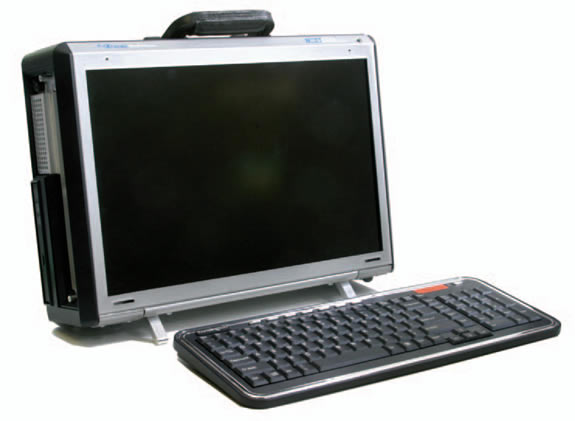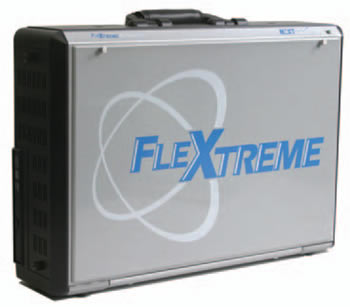Heavy-Duty Portable
The briefcase-sized FleXtreme NextDimension Pro HD Flextop computer offers high-definition graphics for processing out in the field.
Latest News
December 4, 2001
By David Cohn
Although it has been around since 1999, NextComputing wasn’t a name I was familiar with. Based in Nashua, NH, the company is somewhat unique in that it specializes in high-performance portable computers, including notebooks, rugged portables for use in harsh non-office environments, and what the company refers to as flextops — systems “characterized by portability and open standards architecture, which is distinctly flexible and expandable.”
 Removing the side panel exposes the system’s built-in 17-in. LCD display. Pivoting legs and stabilizing feet hold the system at a 7-degree angle.The keyboard is completely separate from the computer. |
The NextDimension Pro HD workstation system comes housed in a black and silver briefcase-sized package measuring 16.75 in. 3 4.5 in. 3 11.5 in. with a leather handle. While what’s inside definitely meets the description of a real workstation, the whole package is meant to be picked up and carried wherever you need to go. Our evaluation system, though, weighed nearly 19 pounds, and that wasn’t counting the additional components you need to take with you, which bring the total weight to 25 pounds. We’ve seen other luggable systems that integrated an LCD panel and computer into a single package — the MaxPac from MaxVision comes to mind — but they usually include a keyboard as part of a removable panel that conceals the LCD screen. The NextDimension Pro HD doesn’t do that. Instead, NextComputing includes a Kensington 104-key USB keyboard and Logitech optical wheel mouse that you carry in the beautiful ballistic nylon carrying case that NextComputing includes (optional hard cases are also available).
Quirky setup
Setting up the NextDimension Pro HD is a bit quirky. First, you remove the aluminum cover protecting the LCD screen by unscrewing two small thumbscrews. Then, you remove a small metal cover on the right side of the computer to reveal the four USB ports, so that you can plug in the keyboard and mouse. That cover also reveals two external SATA drive connectors, a pair of 9-pin serial ports, and a RJ45 network connection.
Removing a larger metal cover on the left side reveals two more Gigabit Ethernet connections, an external VGA port, a single PS/2 keyboard/mouse port, and the DVI-I ports on the system’s graphics card. One of those DVI ports already had a cable from the built-in LCD panel connected to it. You’ll need to put all of these covers in a safe place (the carrying case comes to mind) so that you don’t lose them.
To ensure stability, you also need to lay the case down so that you can extend the metal stabilizers on the bottom of the case, after which you swing out the feet on the bottom of the case so that the LCD screen can be viewed at a more comfortable 7-degree angle. The A/C power cord plugs in on the right side.
Finally, we were ready to power up the NextDimension Pro HD by pressing the power button on the rear of the case. The system quickly booted to Windows XP, but the noise of all the small high-speed fans cooling this system, particularly those in the 400-watt power supply, proved overpowering. This is by far the loudest computer we’ve ever encountered, and since the system is meant to sit on a desk directly in front of you, there’s no easy way to muffle the sound as you might with a tower case tucked under your desk. This, however, might not make much of a difference with the high-end analysis and engineering users who need to take a full-powered workstation into the field for oil & gas, military, emergency, and test and measurement purposes. NextComputing also sells a version called the NextDimension Pro, which doesn’t have the integrated monitor, making the system a bit lighter and less expensive as well. You could put this model under your desk, but then you’d have to supply your own monitor.
Powerful…but not very fast
With the system’s patented mid-plane design, NextComputing packs a lot into its luggable package. The NextDimension Pro HD can be equipped with one or two AMD Opteron CPUs, either single or dual-core, and up to 16GB of memory. Our evaluation unit came with a pair of 1.8GHz dual-core AMD Opteron 265 HE processors and 4GB of memory installed as four 1GB DIMMs. The HE designation indicates a 55-watt low-power processor. This CPU, which has a 1MB L2 cache, also comes in 1.6, 2.0, and 2.2GHz variants and is based on a 90nm fabrication process.
 The NextDimension Pro HD computer comes in an almost self-contained briefcase-sized luggable package. |
NextComputing offers systems with either ATI or NVIDIA graphics boards, and the Pro HD supports up to two NVIDIA Quadro FX cards. Our system came equipped with the brand new NVIDIA Quadro FX 4600 by PNY Technologies, an ultra high-end graphics accelerator, with 768MB of onboard memory (June 2007 DE). The NVIDIA card powers the built-in 17-in. LCD at a maximum resolution of 1920 3 1200 pixels while also driving an external monitor at up to 2560 3 1600 pixels. The built-in thin film transistor LCD panel was quite susceptible to glare, however, and the only way to adjust its brightness was via the NVIDIA driver.
There’s also potentially room for five expansion cards, although only two expansion slots will ever be available, with the combination depending on the graphics cards and drive options installed. The system accommodates one or two SATA hard drives, and our evaluation unit came with a pair of 100GB Seagate Momentus 7,200 rpm drives in a RAID 1 (mirrored) array. If one drive were to fail, we could quickly hot-swap in a new drive with no data loss. Our system also came with an NEC 8X dual layer DVD+/-RW drive. The hard drives and optical drive are located on the left side of the system. With the system in its normal operating position, the optical drive tray slides out in an awkward vertical position, and any cables plugged into ports on the left side can easily get in the way of the drive.
NextComputing provided a CD containing drivers and system documentation in PDF format. We first had to install the Acrobat Reader (also on the CD) however, before we could read the manuals. The bulk of the manual covered system setup and BIOS configuration, but there were several pages dealing with the installation and removal of hard drives and expansion boards. Hard drives can be removed easily via the exposed drive cage on the left side of the system, but in order to access the internal expansion boards, you must first remove the system’s bottom panel (the one supporting the extension feet) and then carefully access the very cramped interior. There are no instructions covering the installation of additional memory; for that you’ll need to return your system to NextComputing.
To evaluate the NextDimension Pro HD, we ran our standard set of benchmarks, including our new AutoCAD rendering test that we use to get a better picture of the multitasking capabilities of multicore CPUs. Windows XP saw the Pro HD’s two dual-core Opteron CPUs as a total of four processors.
Thanks to the system’s NVIDIA Quadro FX 4600 graphics accelerator, the SPEC viewperf results placed the NextDimension Pro HD among some of the faster workstations we’ve reviewed on some tests, while closer in performance to older single and dual-core workstations on other datasets. The results also surpassed recent notebook computers on most, but not all, of the datasets. Clearly the speed of the CPU has a significant impact on graphics performance.
On the SPEC SolidWorks benchmark, the impact of CPU speed was even more dramatic. The NextComputing NextDimension Pro HD lagged behind almost every system we’ve tested in the past two years, both portables and workstations, and recorded the lowest I/O scores of all (see the accompanying spreadsheet for complete benchmark results).
Despite the fact that the system had the equivalent of four CPUs, our NextDimension Pro HD took 243 seconds to complete the Autodesk rendering test, placing it about equal to systems equipped with one faster dual-core CPU. The NextDimension Pro HD is certainly a workstation-class machine, but not a particularly fast one.
NextComputing backs its computers with just a one-year warranty. Systems must be returned to NextComputing for service, however. The company offers two- and three-year extended plans at 8 percent of the purchase price — $794 in the case of our evaluation unit — per year.
Although the system has three LAN ports (so that the system can be used as a high-end mobile server and data-streaming system as well as a workstation), and two serial ports, there’s no parallel port, no FireWire, and no audio. NextComputing says its customers don’t want parallel ports, and audio can be added via an additional PCI card or small USB audio adapter. Placing the NextDimension Pro HD in any orientation other than its vertical operating position is also problematic, because there are no rubber feet except on the bottom. Laying the system onto its back depresses the power button. Laying it down on its front (with the panel covering the LCD panel, of course) causes it to rest on the two thumbscrews. The supplied Kensington keyboard falls somewhat short if you touch type. And with a price as tested of $9,925, this NextDimension Pro HD doesn’t offer much of a price/performance ratio as compared to other systems we’ve reviewed. A system with a single 2.2GHz single-core CPU, 1GB of memory, two slower 100GB hard drives, and on-board ATI Radeon Mobility graphics brings the price down to $5,020.
Although our evaluation unit came with Windows XP Professional, NextComputing also sells and supports systems with Windows 64-bit, Win 2003 Server, Vista Premium, Suse Linux, Red Hat Linux, Fedora Core, and Solaris x86.
We’re sure there’s a niche for a system like this — people who often travel to field locations and need something more powerful and upgradeable than a notebook computer. But the truth is there are several notebook computers available today that deliver similar, or even better performance, and at commodity prices.
NextCom, LLC
Nashua, NH
nextcomputing.com
NextCom FleXtreme NextDimension Pro HD flextop computer
> Price: $9,925 as tested
> Size: 16.75 in. 3 4.5 in. 311.5 in. (W3D3H) briefcase-sized transportable
> Weight: 18.75 pounds (system only, not including accessories)
> CPU: two dual-core AMD Opteron 265 HE processors
> Memory: 4GB
> Graphics: NVIDIA Quadro FX 4600
> Hard Disk: two Seagate Momentus 100GB 7,200 rpm SATA
> Floppy: none
> Optical: NEC 8X dual layer DVD+/-RW drive
> Audio: none
> Network: three Gigabit LAN ports
> Modem: none
> Other: two 9-pin serial, four USB 2.0, two external SATA, PS/2 mouse/keyboard
> Keyboard: 104-key Kensington Slim Type (Model K64365)
> Pointing device: two-button Logitech optical wheel mouse
David Cohn is a computer consultant and technical writer based in Bellingham, WA, and has been benchmarking PCs since 1984. He’s a contributing editor to DE, an applications engineer with The PPI Group, and the author of more than a dozen books. Please send comments about this article to [email protected]. You can also contact David at [email protected] or at dscohn.com.
Subscribe to our FREE magazine, FREE email newsletters or both!
Latest News
About the Author
David Cohn is a consultant and technical writer based in Bellingham, WA, and has been benchmarking PCs since 1984. He is a Contributing Editor to Digital Engineering, the former senior content manager at 4D Technologies, and the author of more than a dozen books. Email at [email protected] or visit his website at www.dscohn.com.
Follow DE





